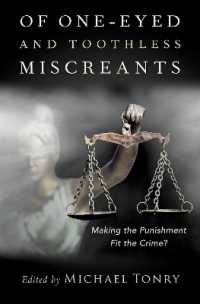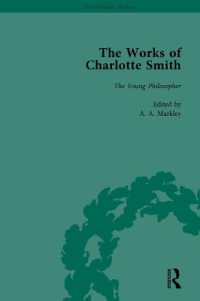Full Description
ALERTcourse syllabus to ensure that you select the correct ISBN. Several versions of Pearson's MyLab & Mastering products exist for each title, including customized versions for individual schools, and registrations are not transferable. In addition, you may need a CourseID, provided by your instructor, to register for and use Pearson's MyLab & Mastering products.PackagesAccess codes for Pearson's MyLab & Mastering products may not be included when purchasing or renting from companies other than Pearson; check with the seller before completing your purchase.Used or rental booksIf you rent or purchase a used book with an access code, the access code may have been redeemed previously and you may have to purchase a new access code.Access codesAccess codes that are purchased from sellers other than Pearson carry a higher risk of being either the wrong ISBN or a previously redeemed code. Check with the seller prior to purchase.--The definitive research paper guide, Writing Research Papers combines a traditional and practical approach to the research process with the latest information on electronic research and presentation.This market-leading text provides students with step-by-step guidance through the research writing process, from selecting and narrowing a topic to formatting the finished document. Writing Research Papers backs up its instruction with the most complete array of samples of any writing guide of this nature. The text continues its extremely thorough and accurate coverage of citation styles for a wide variety of disciplines. The fourteenth edition maintains Lester's successful approach while bringing new writing and documentation updates to assist the student researcher in keeping pace with electronic sources.
Contents
PrefaceChapter 1 Writing from Research1a Why Do Research?1b Learning The Conventions of Academic Writing1c Understanding and Avoiding Plagiarism1d Understanding a Research AssignmentUnderstanding the Terminology1e Establishing a Research ScheduleChapter 2 Finding a Topic2a Relating Your Personal Ideas to a Scholarly ProblemConnecting Personal Experience to Scholarly TopicsSpeculating about Your Subject to Discover Ideas and to Focus on theIssues2b Talking with Others to Find and Refine the TopicPersonal Interviews and DiscussionsOnline Discussion Groups2c Using Online Searches to Refine Your TopicUsing an Online Subject DirectoryUsing an Internet Keyword Search2d Using the Library's Electronic Databases to Find and Narrow a Subject2e Using the Library's Electronic Book Catalog to Find a Topic2f Developing a Thesis Statement, Enthymeme, or Hypothesis2g Drafting a Research ProposalThe Short ProposalThe Long ProposalYour Research ProjectChapter 3 Organizing Ideas and Setting Goals3a Using a Basic Order to Chart the Course of Your Work3b Using Your Research Proposal to Direct Your Notetaking3c Listing Key Terms and Phrases to Set Directions for Notetaking3d Writing a Rough Outline3e Using Questions to Identify Issues3f Setting Goals by Using Organizational Patterns3g Using Approaches across the Curriculum to Chart Your Ideas3h Using Your Thesis to Chart the Direction of Your ResearchYour Research ProjectChapter 4 Gathering Sources Online4a Beginning an Online SearchCHECKLIST: Evaluating Internet Sources4b Reading an Online Address4c Using Keyword and Boolean ExpressionsSubject Directory Search EnginesRobot-Driven Search EnginesMetasearch EnginesSpecialized Search EnginesEducational Search EnginesEducational Search Engines Maintained by Libraries4d Using RSS and Social BookmarkingRSS FeedsWeb and Social Bookmarking4e Searching for Articles in Journals and MagazinesOnline journals Online Magazines 4f Searching for Articles in Newspapers and Media Sources4g Searching for Photographs and Other Visual Sources4h Accessing E-Books4i Using Listserv, Usenet, Blogs, and Chat GroupsE-mail News GroupsReal-Time Chatting4j Examining Library Holdings via Online Access4k Finding an Internet Bibliography4l Conducting Archival Research on the InternetGo to the LibraryGo to an Edited Search EngineGo to a Metasearch EngineGo to a Listserv or Usenet GroupUtilize Newspaper ArchivesYour Research ProjectChapter 5 Gathering Data in the Library5a Launching the Search5b Developing a Working Bibliography5c Finding Books on Your TopicUsing Your Library's Electronic Book CatalogUsing the Library's Bibliographies5d Finding Articles in Magazines and JournalsSearching the General Indexes to PeriodicalsFinding Indexes by Topic in Appendix BReaders' Guide to Periodical LiteratureSocial Sciences IndexHumanities IndexSearching for an Index to AbstractsSearching for Abstracts of Dissertations5e Searching for a BiographyBiography IndexCurrent Biography YearbookContemporary AuthorsDictionary of Literary Biography 5f Searching for Articles in the Newspaper Indexes5g Searching Special Subject Directories5h Searching for Government Documents5i Searching for Essays within BooksYour Research ProjectChapter 6 Conducting Field Research6a Investigating Local SourcesInterviewing Knowledgeable PeopleWriting Letters and Corresponding by E-mailReading Personal PapersAttending Lectures and Public Addresses6b Investigating Government Documents6c Examining Audiovisual Materials, Television, and Radio6d Conducting a Survey with a Questionnaire6e Conducting Experiments, Tests, and ObservationYour Research ProjectChapter 7 Understanding and Avoiding Plagiarism7a Using Sources to Enhance your Credibility7b Placing Your Work in Its Proper Context7c Understanding Copyright7d Avoiding PlagiarismCommon KnowledgeCorrectly Borrowing from a Source7e Sharing Credit in Collaborative Projects7f Honoring and Crediting Sources in Online Classrooms7g Seeking Permission to Publish Material on Your Web SiteYour Research ProjectChapter 8 Reading and Evaluating Sources8a Finding Reliable Sources8b Selecting a Mix of both Primary and Secondary Sources8c Evaluating SourcesEvaluating the Key Parts of an Article Evaluating the Key Parts of a BookEvaluating the Key Parts of an Internet Article8d Outlining a Source8e Summarizing a Source8f Preparing an Annotated Bibliography8g Preparing a Review of the Literature on a TopicYour Research ProjectChapter 9 Writing Effective Notes and Creating OutlinesGathering Printouts, Photocopies, Scanned Images, and Downloaded DataWriting Notes of High Quality9a Creating Effective NotesHonoring the Conventions of Research StyleUsing a Computer for Notetaking9b Writing Personal Notes9c Writing Direct Quotation NotesQuoting Primary SourcesQuoting Secondary Sources9d Writing Paraphrased Notes9e Writing Summary Notes9f Writing Precis NotesUse the Precis to Review Briefly an Article or BookUse the Precis to Write an Annotated BibliographyUse the Precis in a Plot Summary NoteUse the Precis As the Form for an Abstract9g Writing Notes from Field Research9h Creating Outlines Using Academic ModelsA General All-Purpose ModelModel for Advancing Your Ideas and TheoriesModel for the Analysis of Creative WorksModel for Argument and Persuasion PapersModel for Analysis of HistoryModel for a Comparative Study9i Writing a Formal OutlineUsing Standard Outline SymbolsWriting a Formal Topic OutlineWriting a Formal Sentence OutlineYour Research ProjectChapter 10 Drafting the Paper in an Academic Style10a Focusing Your ArgumentMaintaining a Focus on Objective Facts and Subjective Ideas10b Refining the Thesis StatementUsing Questions to Focus the ThesisAdjust or Change Your Thesis during Research if Necessary10c Writing an Academic Title10d Drafting the Paper from Your Research Journal, Notes, and Computer FilesWriting from Your NotesWriting with Unity and CoherenceWriting in the Proper TenseUsing the Language of the DisciplineUsing Source Material to Enhance Your WritingWriting in the Third PersonWriting with the Passive Voice in an Appropriate Manner10e Using Visuals Effectively in a Research EssayFile Formats10f Avoiding Sexist and Biased LanguageYour Research ProjectChapter 11 Blending Reference Material into Your Writing by Using MLA Style11a Blending Reference Citations into Your TextMaking a General Reference without a Page NumberBeginning with the Author and Ending with a Page NumberPutting the Page Number Immediately after the NamePutting the Name and Page Number at the End of Borrowed Material11b Citing a Source When No Author Is ListedCiting the Title of a Magazine ArticleCiting the Title of a ReportCiting the Name of a Publisher or a Corporate Body11c Citing Nonprint Sources That Have No Page Number11d Citing Internet SourcesIdentify the Source with Name or TitleIdentify the Nature of the Information and Its CredibilityOmitting Page and Paragraph Numbers to Internet Citations11e Citing Indirect Sources11f Citing Frequent Page References to the Same Work11g Citing Material from Textbooks and Large Anthologies11h Adding Extra Information to In-text CitationsOne of Several VolumesTwo or More Works by the Same WriterSeveral Authors in One CitationAdditional Information with the Page Number11i Punctuating Citations Properly and With ConsistencyCommas and PeriodsSemicolons and ColonsQuestion Marks and Exclamation MarksSingle Quotation Marks11j Indenting Long Quotations11k Citing PoetryQuoting Two Lines of Poetry or LessQuoting Three Lines of Poetry or MoreIndenting Turnovers for Long Lines of PoetryRetaining Internal Quotations within a BlockProviding Translations11l Handling Quotations from a Play11m Altering Initial Capitals in Some Quoted Matter11n Omitting Quoted Matter with Ellipsis Points11o Altering Quotations with Parentheses and BracketsParenthesesBracketsYour Research ProjectChapter 12 Writing the Introduction, Body, and Conclusion12a Writing the Introduction of the PaperProvide the Thesis StatementProvide the EnthymemeProvide a HypothesisRelate to the Well KnownProvide Background InformationReview the LiteratureReview the History and Background of the SubjectTake Exception to Critical ViewsChallenge an AssumptionProvide a Brief SummaryDefine Key TermsSupply Data, Statistics, and Special Evidence12b Writing the Body of the Research PaperOrganize by ChronologyCompare or Contrast Issues, Critical Views, and Literary CharactersDevelop Cause and EffectDefine Your Key TerminologyExplain a ProcessAsk Questions and Provide AnswersCite Evidence from the Source MaterialsUse a Variety of Other Methods12c Writing the Conclusion of the Research PaperRestate the Thesis and Reach beyond ItClose With an Effective QuotationReturn the Focus of a Literary Study to the AuthorCompare the Past to the PresentOffer a Directive or SolutionDiscuss Test ResultsYour Research ProjectChapter 13 Revising, Proofreading, and Formatting the Rough Draft13a Conducting a Global RevisionRevising the IntroductionRevising the BodyRevising the ConclusionParticipating in Peer Review13b Formatting the Paper to MLA StyleTitle Page or Opening PageOutlineAbstractThe Text of the PaperContent Endnotes PageAppendixWorks Cited13c Editing Before Typing or Printing the Final ManuscriptUsing the Computer to Edit Your Text13d Proofreading on the Screen and on the Printed ManuscriptYour Research Project13e Sample Research Papers in MLA StyleShort Literary Research PaperSample Research PaperChapter 14 Works Cited: MLA Style14a Formatting the Works Cited PageIndex to Works Cited Models: MLA STYLE14b Works Cited Form - Internet Sources14c Works Cited Form - Citing Database and CD-ROM SourcesOther Electronic Sources14d Works Cited Form - Books14e Works Cited Form - Periodicals14f Works Cited Form - Newspapers14g Works Cited Form - Government Documents14h Works Cited Form - Other SourcesChapter 15 Writing in APA Style15a Writing Theory, Reporting Test Results, or Reviewing LiteratureTheoretical ArticleReport of an Empirical StudyReview Article15b Writing in the Proper Tense for an APA Research Paper15c Using In-text Citations in APA Style15d Preparing the List of ReferencesIndex to Bibliographic Models: APA styleBookPeriodicalAbstractReviewReportNonprint MaterialInternet SourcesWorld Wide Web SitesArticle from a Library DatabaseCD-ROM15e Formatting an APA PaperTheoretical ArticleReport of Empirical ResearchReview Article15f Writing the Abstract15g Sample Paper in APA StyleChapter 16 The Footnote System: CMS Style16a Inserting a Superscript Numeral in Your Text 16b Formatting and Writing the Footnotes 16c Writing Footnotes for Electronic Sources16d Writing Subsequent Footnote References16e Writing Endnotes rather than Footnotes16f Writing Content Footnotes or Content Endnotes16g Using the Footnote System for Papers in the Humanities16h Writing a Bibliography Page for a Paper That Uses Footnotes16i Sample Research Paper in the CMS StyleChapter 17 CSE Style for the Natural and Applied SciencesGuide by DisciplineIndex to Bibliographic Models: CSE style17a Writing In-Text Citations Using the CSE Citation-Sequence System17b Writing a Reference Page17c Writing In-Text Citations with Name and Year17d Using Name-Year with Bibliography Entries17e Sample Paper Using the CSE Citation-Sequence SystemChapter 18 Creating Electronic Research Projects18a Beginning the Electronic Project18b Building Electronic Presentations18c Research Paper Web Pages and SitesCreating a Single Web PageImporting, Entering, and Modifying TextCiting Your Sources in a Web Research Paper18d Using Graphics in Your Electronic Research PaperGraphic File FormatsCreating Your Own Digital Graphics18e Using Sound and Video in Your Electronic Research Paper18f Preparing a Writing Portfolio18g Presenting Research in Alternative FormatsYour Research ProjectAppendix A Glossary: Rules and Techniques for Preparing the Manuscript in MLA StyleAppendix B Finding Reference Works for Your General TopicHistoric Issues of Events, People, and ArtifactsScientific Issues in Physics, Astronomy, and EngineeringIssues of Health, Fitness, and AthleticsSocial and Political IssuesIssues in the Arts, Literature, Music, and LanguageEnvironmental Issues, Genetics, and the Earth SciencesIssues in Communication and Information TechnologyIssues in Religion, Philosophy, and PsychologyIssues in Business and EconomicsPopular Culture, Current Events, and Modem Trends CreditsIndex








